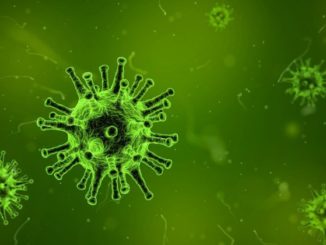
Na quinta-feira, 23, Fiama Martins, pesquisadora vinculada ao Centro de Desenvolvimento de Materiais Funcionais (CDMF), apresentou o seminário intitulado “Chitosan, poly(N-vinylcaprolactam), and silica nanoparticles Sponges and gels as a Clotrimazole Delivery System for the Treatment of Vulvovaginal Candidiasis”.
Martins expôs os resultados do estudo que aborda a atividade de esponjas de quitosana – um biomaterial adequado para aplicações biológicas – carregadas com clotrimazol contra espécies do fungo Candida para o tratamento da candidíase vulvovaginal. A banca avaliadora que acompanhou o seminário foi formada pelos docentes Tatiane Moraes Arantes, da Universidade Federal de Goiás (UFG), e Felipe Christoff Wouter, da Universidade Federal de São Carlos (UFSCar).
Orientanda de Emerson Camargo, também pesquisador do CDMF e professor da UFSCar, Martins está atualmente realizando intercâmbio acadêmico no Instituto de Investigação e Inovação em Saúde na Universidade do Porto, sob a supervisão dos professores José das Neves e Bruno Sarmento, investigador principal do grupo Nanomedicines and translational drug delivery, do qual Martins é colaboradora.
Resumo do seminário: Despite the incredible advancement in therapeutic efficiency in the treatment of various diseases, enhancing a suitable drug delivery system (DDS) remains a challenge that needs to be defeated. There are several routes of drug administration, including enteral (oral, sublingual), parenteral (intramuscular injection, intravenous injection), topical (epidemic, irrigation), and inhalation (vaporization, nebulization).1,2 Many kinds of DDS applied to the vaginal area are made of polymeric materials chemically or physically cross-linked. Chemically cross-linked gels are obtained by covalent bonds and can present more rigid networks. On the other hand, physically cross-linked gels are formed by intermolecular forces and/or entanglements that present more flexible networks.3 The hybrid biomaterials based on chitosan (Ch), poly (N-vinylcaprolactam) (PNVCL), and silica nanoparticles (SiO2) have interesting properties, such as pH and thermal sensibility, mucoadhesion, biocompatibility, and antimicrobial activity, which could make them an excellent candidate to use as a vehicle of drug delivery for the vaginal mucosa.4,5 In this work, we aimed to analyze the physical-chemical properties of the hybrid materials based on chitosan hydrogels with different amounts of PNVCL and PNVCL-SiO2. We hypothesize that the combination of the physical-chemical properties of these biocompatible polymers and NPs can generate an intelligent vehicle, biocompatible and pH-thermo-responsive for vaginal DDS. All study hydrogels were obtained by the physical method, following the procedure reported by Popa-Nita et al.6 The concentration of Ch solution (high M.W. and 27% DA) was maintained equal to 1.1% (w/v), which was prepared in the acetic acid (0.35% v/v) aqueous solution for 24 hours. The hydrogels were obtained by putting in contact a Ch, Ch-PNVCL, and Ch- PNVCL-SiO2 solutions with gaseous ammonia to the obtention of reticulated gels. After 72 hours, the materials were washed until the water neutralization. The final hydrogels present three different amounts of PNVCL and PNVCL-SiO2 (3:1, 1:1, and 1:3 (w/w)). The chitosan sponges and its hybrid materials were prepared the freeze-drying of the gels. obtained by physical reticulation under an ammonia atmosphere after the washing process. The materials were characterized according to their chemical composition, thermal analysis, rheology, morphology, texture, and antifungal activity against some candida species. The gels and the sponges were studied to comprehend their potential application as a DDS in the vaginal route for the treatment of candida. The morphology and chemical structure of MSN and the nanocomposites were characterized by scanning electron microscopy (SEM), Brunauer–Emmett–Teller (BET) method, Fourier-transform infrared spectroscopy (FTIR), and nuclear magnetic resonance spectroscopy (NMR) of hydrogen. The thermal properties were characterized by differential scanning calorimetry (DSC) and thermogravimetric analysis (TGA). UV-Vis spectroscopy was used to determine the macromolecules’ Lower Critical Solution Temperature (LCST) considering the phase transition with the temperature variation. The mechanical properties of hydrogels were studied using a rheometer to evaluate the oscillation and frequency measurements at 37 oC to determine the elastic modulus and loss modulus. This data allows us to predict the biophysical property of the gel and its applicability as DDS in a vulvovaginal environment. The Ch-CTZ and pure CTZ were tested for activity against Candida species according to CLSI protocol M27-A4 by determining the minimum inhibition concentration (MIC) and the minimum fungicide concentration (MFC).7 The pure and hybrid Ch and PNVCL materials presented thermal stability under the application range, not being degraded. The PNVCL and PNVCL-SiO2 presented LCST equal to 35oC, which is near to the physiological temperature. The presence of nanoparticles directly affects the optical properties of PNVCL, as we observed a higher optical density in the PNVCL-SiO2 compared to pure PNVCL. This means that the SiO2 facilitates the aggregation that occurs to PNVCL in the LCST, decreasing the water-polymer interaction. 4 The practical application in the perspective of a DDS is that during the agglomerated form, the polymer can encapsulate drug molecules inside its structure and retain it, providing a controlled liberation. The gel formed with Ch-PNVCL and Ch-PNVCL-SiO2 is a solid-like gel that has great potential for application in the topic administration route because it can encapsulate a large number of drugs inside. It is very porous and physically stable in a large range of critical oscillation stress, which means that the gels present high resistant 3D microstructure3. The only limitation of its application as a DDS in the vaginal channel is that these kinds of systems can present limitations during the application because of the poor liquid viscous property on which the vaginal applicators are based on3. However, the use of the freeze-dried gel generates elastic and soft sponges that can be applied and swell with the vaginal fluid for the delivery of drugs. The sponges were loaded with clotrimazole, an antifungal molecule used for the treatment of vulvovaginal candidiasis, and it presented association efficiency and loading capacity of 100% and 50%, respectively. These results mean that the drug has a good chemical interaction with the polymeric matrix and is not removed from the polymer with the washing process of the synthesis. The antifungal results showed that Ch-CTZ caused a slight increase of MIC and MFC values against C. albicans ATCC 90028, C. tropicalis ATCC 750, C. krusei ATCC 6258, and C. albicans SC5314 when compared to the pure drug. Differences were minor (no more than two-fold), and the MICs were lower or equal to 16 µg/mL. Cytotoxicity studies using female genital tract cell lines are currently underway. According to the results obtained so far, the chitosan and its hybrid sponges appear to be a promising formulation to be used in the treatment of VVC due to its high drug loading capability and maintenance of the activity of CTZ.
CDMF
O CDMF é um dos Centros de Pesquisa, Inovação e Difusão (Cepids) apoiados pela Fundação de Amparo à Pesquisa do Estado de São Paulo (Fapesp), e recebe também investimento do Conselho Nacional de Desenvolvimento Científico e Tecnológico (CNPq), a partir do Instituto Nacional de Ciência e Tecnologia dos Materiais em Nanotecnologia (INCTMN).




